While I’m a big fan of food being a celebration, sometimes after a holiday or just a stretch of indulgent food choices, it feels really good to dial it back into simple “clean” eating. These miso lime salmon bowls fit the bill for a nourishing, cleansing dish that also feels super satisfying. They can easily be modified with grain-free, low-carb options as well (like zoodles!).
What’s in these bowls?
Salmon
As the recipe name suggests, these bowls center around miso-glazed, oven-broiled salmon. Salmon provides high-quality protein, omega-3 fatty acids, and many other nutrients that your body needs and craves.
When it comes to buying this fish, wild Alaskan salmon and farmed Arctic Char are the healthiest, most eco-friendly options. We love adding salmon and other seafood options to our monthly Butcher Box because we know we are always getting the best quality and prices.
If you aren’t already familiar with Butcher Box, it’s a monthly meat box subscription that sources only the highest quality pasture-raised meat, poultry, and sustainable fish. They always have some great deals, (like ground beef or bacon for life!), so if you don’t already use them, check out Butcher Box here.
Miso
Miso is a fermented paste, usually made from soybeans, that imparts a sweet umami flavor into dishes. You can usually find it at Asian markets or in the ethnic food section of the grocery store, but I order mine online from Thrive Market.
As you may already know, consumption of too much soy can be an issue due to the presence of phytic acid in legumes, grains, nuts (which interferes with nutrient absorption) and phytoestrogens (that can be endocrine disruptors if consumed in large quantities).
But because miso is fermented, it contains bacteria which has eaten the sugars and starches present in the food. This process preserves the food and also gives it probiotics, enzymes, and additional vitamins. It makes the food more easily digested and the nutrients easier for the body to use.
Generally, the darker colored the miso, the stronger the flavor. For this recipe, we use white miso, but feel free to experiment to suit your tastes.
Kale
Oh, kale. The darling health food of modern times. A few secrets I’d like to share about this vegetable. Whenever possible, opt for Lacinato kale (a.k.a. “dinosaur kale”) over the curly variety that is lighter green in color and less enjoyable to eat because of its tough, almost spiny textured leaves.
My second secret of kale is a step of preparation that often gets ignored: I highly recommend that you destem your kale. The easiest way to do this is by stripping the leave from the stem. Holding the stem of the kale, grasp the base of the leave with your other hand, moving from the bottom to the top of the leaf, separating the more tender leaves from the fibrous stalk. Repeat this for all of your kale. Discard stems and then chop the kale per your recipe’s instructions. I promise that this method will speed up your prep time and make kale chewing so much more enjoyable.
Udon
Udon, a Japanese comfort food, is a thick wheat-based noodle – think fat, starchy spaghetti – often used in soups. In this dish, the udon roots give balance to the other light, bright ingredients and makes it a more filling meal.
If you want to avoid wheat you can use a rice noodle instead. And if you’d prefer a less caloric option, simply omit the udon and consider doubling the kale. Another fun, grain-free alternative would be zoodles. If you haven’t tried them yet, you can learn how to make zoodles here.
Avocado
Avocados are perfect team player when it comes to food. Want to eat “healthy”? Avocado. Want to feel like you’re indulging? Avocado. Personally, I’m a big fan of avocado and salmon in combination like in this recipe.
Ginger
In the culinary world, ginger – a yellow-fleshed root – originated in Asia and was introduced to the western world via the Spice Trade. In Chinese medicine (as well as western herbology), ginger is a commonly used medicinal plant to improve digestion and fortify the immune system. In this dish, the ginger is combined with the miso, rice wine vinegar, lime juice, and garlic powder to create the flavorful marinade that makes the salmon extra special.
How to meal plan with our miso lime salmon bowls
These salmon bowls are perfect to serve for weeknight dinner. You’ll need to marinate the salmon for at least 2-3 hours, but beyond that, your total prep and cook time will be less than a half hour.
And because this dish has it all – protein, carbs, good fats – you really don’t need to plan for any sides.
Got a picky kid or partner? Make it DIY bowl night when you serve the ingredients separately and everyone can add what they want to eat so nothing goes to waste.
Save
Miso Lime Salmon Bowls
- 2h 40m
- 20m
- 3h
Ingredients
- 4 tsp. white miso
- fresh ground black pepper
- 1 avocado
- 1 pinch coarse sea salt, plus more to taste
- extra virgin olive oil, for kale
- 1 bunch kale
- 1 pkg udon noodles
- 1 1/2 2 pounds wild caught salmon (6 oz filet per person)
- 1/2 tsp. garlic powder
- 4 limes
- 2 tbsp. rice wine vinegar
- 1 1/2 inches ginger
For the dressing:
- 2 tbsp. rice wine vinegar
- 2 tsp. sesame oil
- 4 tsp. raw honey
- 1 pinch chili flakes, optional
Instructions
- Juice half of the limes for the marinade. Quarter lime (one slice per serving for garnish). Peel and grate the ginger.
- In a shallow dish big enough to hold the salmon in a single layer, combine miso, ginger, rice wine vinegar, lime juice, and garlic powder. Add the salmon filets and refrigerate for 2-3 hours.
- Preheat oven to 425F.
- Fill a medium-sized saucepan with filtered water, add a generous pinch of salt and bring to a boil. Meanwhile prepare the veggies in the next step. Add the udon noodles. Cook according to instructions on the package, and rinse with cold water after draining. Set aside.
- Prepare the kale: Holding the stem of the kale, grasp the stalk with your other hand, moving from the bottom to the top of the leaf, stripping the leaf away from the stalk. Repeat this for all leaves. Discard stems and finely chop the leaves. Set aside.
- Prepare garnishes: Slice green onions thinly on the diagonal; peel and thinly slice avocado.
- Remove the salmon from the marinade and place on a baking sheet lined parchment paper or silpat. Bake for about 15 minutes until the salmon is nearly cooked through.
- Switch the oven to the high broiling setting. Add the kale in a single layer to the same baking sheet as the fish, drizzle with olive oil and sprinkle with sea salt. Cook 1-2 minutes with the oven ajar until the kale has crisped. Watch closely to avoid burning the kale. Remove from oven.
- Juice remaining lime for dressing. Add remaining dressing ingredients and whisk well.
- To each serving bowl add: udon, salmon, and kale. Garnish with sliced avocado, green onions, sesame seeds, and a lime wedge. Drizzle with dressing and serve.
Nutrition
- 696
- 47g
- 68g
- 8g
- 26g
- 4g
- 92mg
- 9g
- 922mg
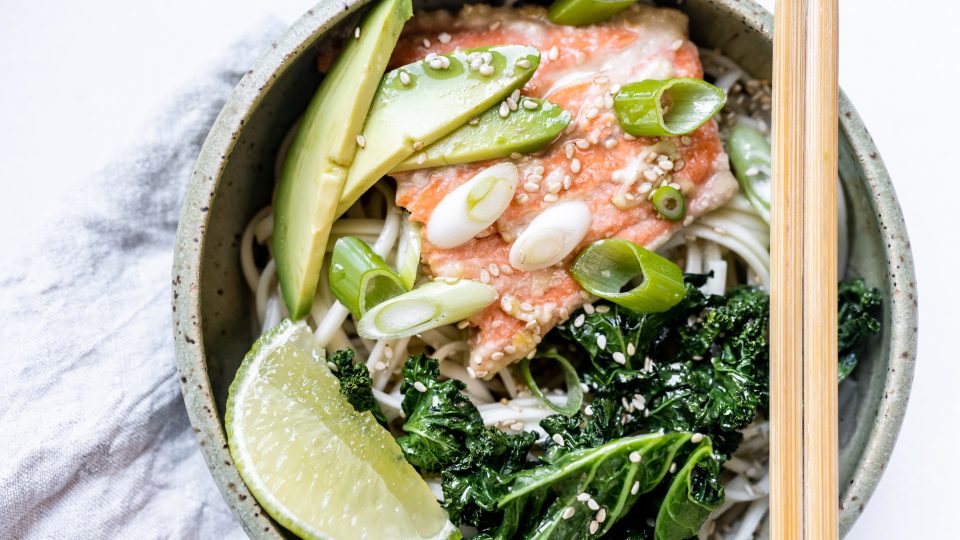

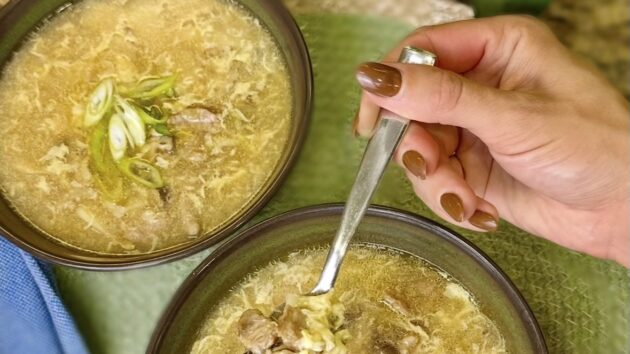
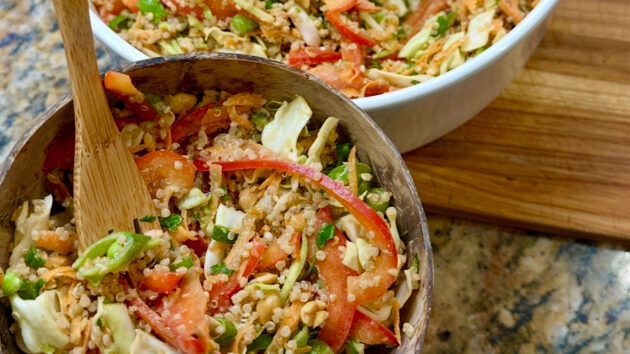

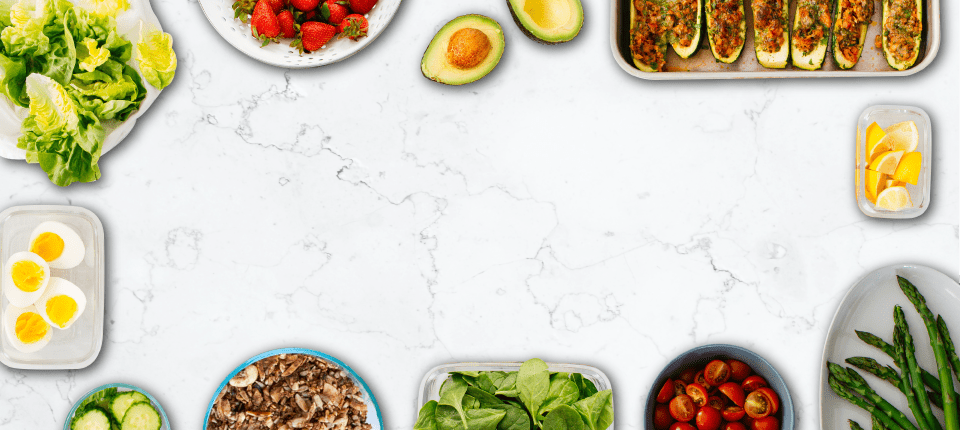
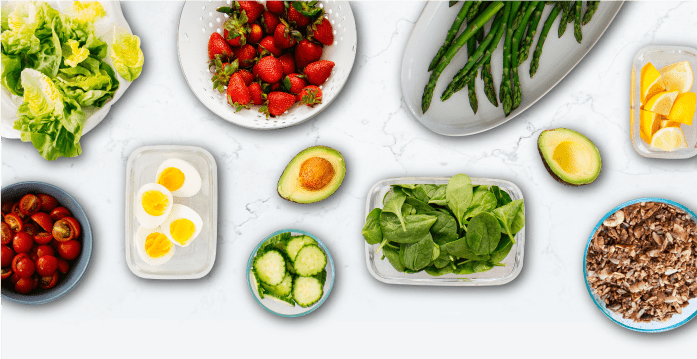
Read Reviews
See what other people are saying about Miso Lime Salmon Bowls
No reviews just yet. You can be the first!